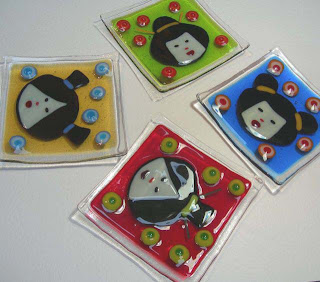How does an idea start? Twenty years ago I worked as a freelance designer and my clients expected me to produce at least 3 to 5 good quality ideas for each brief. Working on new designs with short deadlines made me ideas-rich but, working at that pace, also left me exhausted creatively. Fortunately design is more to do with nurture than nature and, once you are in your stride as a designer, more ideas flow. Imagine your first idea is like an acorn that grows into a strong tree that branches off with similar ideas that then scatters more acorns (ideas) that start the whole process again. That’s how contagious ideas can be!

Where to begin? Anything or anyone can trigger an idea - a landscape, a building, a song, a conversation, a colour ….. it sounds pretentious but it’s true. Are you completely stuck? Don’t have an idea of your own? Stop looking around and look inside yourself instead. What do you like to do? What are your interests? List three things about yourself. Here are some possible examples:
I drink a lot of tea!
I love gardening.
My favourite colour is red.
Three design ideas already. Let’s take a look at Drinking Tea and list words that are linked to this idea:
Tea leaves, tea bags, tea pot, tea cups, tea strainer, tea spoons, sugar bowl, milk jug, saucers, tea plates, biscuits, dainty cakes, napkins, tablecloth….
Now I gave gathered the ideas they need to be developed into a design. What am I going to do with this design? Will it be a collage? Mosaic? Patchwork quilt? Glass dish?
An appliqué quilt based on the idea of Drinking Tea.
Look through magazines and catalogues, selecting and cutting out images of tea pots, cups, cakes, etc.
Make rough drawings of the shapes of the images.
Decide on the shapes you like and photocopy your drawings. Play around with the cut out shapes on a large piece of plain paper. Can you construct a design that you are reasonably happy with?
Look at patterns and colours of china tea sets that you might like to use on your appliqué shapes. Willow pattern? Royal Copenhagen? Stripes and spots? Roses? Plain colours? Check tablecloths?
Spend some time looking at fabrics that will suit the design for a Tea Drinking Applique Quilt. Think about three main things when you select material: colour, pattern and texture.
Where can you keep all these ideas? Becoming ideas-rich and collating images is addictive but it is difficult to develop these ideas if all your reference is loose. You may find ideas for future projects whilst researching for a current project or you may want to go back and look at a previous idea.
There are several ways you can store and group your reference and images. Choose one or more that you are comfortable with and suits you.
Sketchbooks hard backed, A4 or A5 size, plain or patterned cover, artists’ sketch block, children’s drawing pad.
Notebooks plain or lined pages, jotters, exercise books, spiral bound books, hand made books, stapled pages. (You can buy plain books on Dawanda).
Scrap books sugar paper, scrap computer paper, foolscap paper.
Where can you find sources for design? Magazines, children’s books, catalogues, photographs, travel brochures, newspapers, postcards, paint charts, fabric swatches, architecture, nature, patterns, ethnic art, historical and contemporary art, postage stamps, found objects, pebbles, shells…..

Design boards. I like to make design boards, I have been making them since art school (a long time) and still look at the very old ones when I am looking for a fresh idea. This design board is for an idea I have for making glass sushi dishes. I sought out images of origami paper dolls and toys and have included washi paper with some drawings I have made. I am looking at three things: shape, colour and texture. The pleasure of making a design board is arranging the images and then sticking them down.
Working Drawings. Unlike finished drawings, working drawings are dispensable – they can be scribbled over, redrawn and notes made in the margin. Working drawings don’t need to be to scale – that’s the job of the finished drawing. When I have thrashed out several drawings on paper I then draw the exact measurements for a sushi dish and finalise my design.
The finished outcome. So from a design board I have finished a selection of sushi dishes called “The Sushi Girls”. My design board and drawings helped me to resolve problems and adapt my designs for glass.

A quick note about copyright – copyright law is tricky to enforce unless you are a powerful corporation who makes soft drinks or Japanese cartoon cats, or you have a lot of money to enable you to sue. This means that the little people (like you and me who can’t afford to hire lawyers) are vulnerable to having our precious work copied. Here are some does and don’ts:
Do take care when downloading images from Google that you are not infringing others’ copyright. Pasting their images on your design board is fine as long as you are not directly copying their work.
Instead, take a look at Dover Books which are 25% copyright free http://doverbooks.co.uk/ . These books are a fantastic resource.
Make sure that your designs at lest three steps away from the sources of reference you have collected.
Please don’t scan websites like Dawanda and Etsy to directly copy others’ hand made items and then sell them through another selling website. You WILL get found out.
If your idea and design is your own and unique then ask the viewer to respect your copyright.
And finally, please note that this article is solely the property of Glassprimitif. Please do not copy parts of it out for re-publication without the author’s permission.

Great tips! Thanks for sharing!
ReplyDeleteI love those sushi dishes!
ReplyDelete